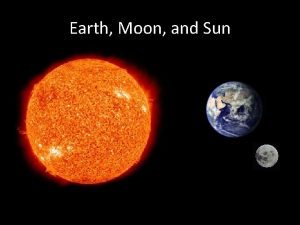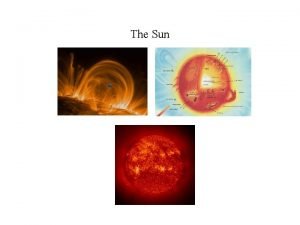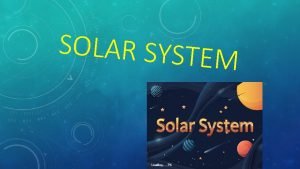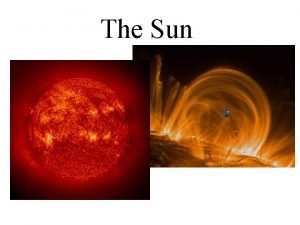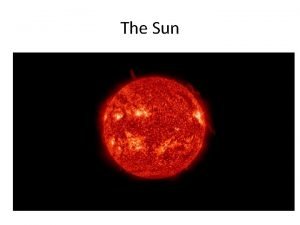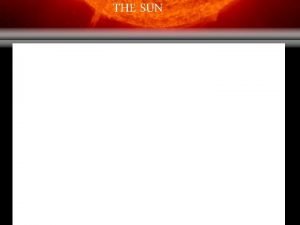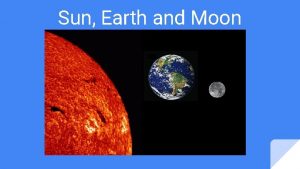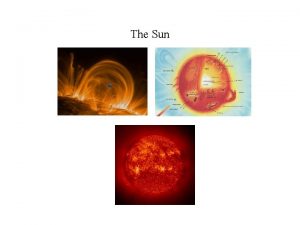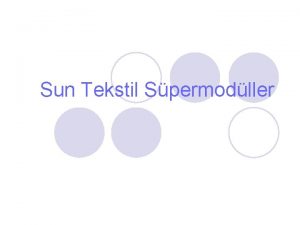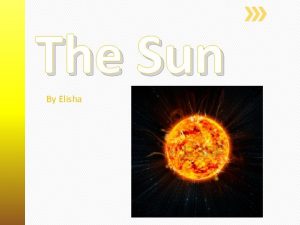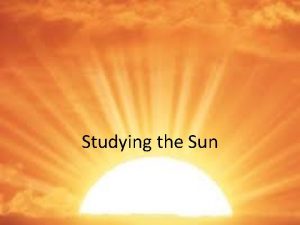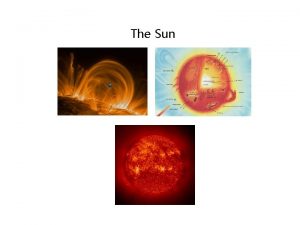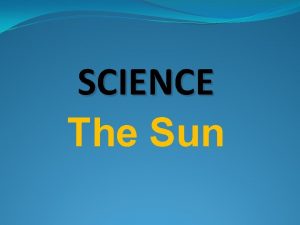Lesson 3 3 The Sun Lesson 3 What















- Slides: 15

Lesson 3. 3: The Sun

Lesson 3: • What is the structure of the sun? • What features can you see on the sun?

What Is the Structure of the Sun? • No solid surface – ¾ of sun’s mass is hydrogen – ¼ of sun’s mass is helium • Has an interior and an atmosphere • Interior is made up of the: – Core – Radiation zone – Convection zone

The Sun’s Interior: The Core • Core: central region of the sun – An enormous amount of energy is produced here through nuclear fusion • Nuclear fusion: when hydrogen atoms join to form helium

The Sun’s Interior: The Radiation Zone • Energy produced in the sun’s core moves outward through the radiation zone • Radiation zone: a region of very tightly packed gas where energy moves mainly in the form of electromagnetic radiation – Is extremely dense; energy can take more than 100, 000 years to move through this zone

The Sun’s Interior: The Convection Zone • Convection zone: the outermost layer of the sun’s interior – Hot gases rise from the bottom of the convection zone and cool as they approach the top – Cooler gases sink, forming loops of gas that move energy toward the sun’s surface (convection currents)

The Sun’s Atmosphere • Stretches far into space • Layers become less dense the farther they are from the radiation zone • Mostly composed of hydrogen and helium • Includes the: – Photosphere – Chromosphere – Corona

The Sun’s Atmosphere: The Photosphere • Photosphere: the inner layer of the sun’s atmosphere – Considered to be the surface layer of the sun • Sun does not have a solid surface, although the gases of the photosphere are thick enough to be visible • When you look at an image of the sun, you see the photosphere

The Sun’s Atmosphere: The Chromosphere • Chromosphere: the middle layer of the sun’s atmosphere; means “color sphere” – The reddish glow visible around the photosphere at the start and end of a total eclipse

The Sun’s Atmosphere: The Corona • Corona: the outer layer that looks like a white halo around the sun; means “crown” – Extends into space for millions of kilometers – Gradually thins into streams of electrically charged particles called the solar wind

What Features Can You See on the Sun? • Using special telescopes to study the sun, scientists have spotted features like: – Sunspots – Prominences – Solar flares

Sunspots • Sunspots: dark areas on the sun’s surface; caused by areas of gas on the sun’s surface that are cooler than the gases around them – Often look small, but they can be larger than Earth – Number of sunspots varies in a regular cycle, with the most sunspots appearing about once every 11 years Sunspots

Prominences • Prominences: huge loops of gas; often link different parts of sunspot regions Prominences

Solar Flares • Solar flares: eruptions that occur when the loops in sunspot regions suddenly connect, releasing large amounts of magnetic energy – The energy heats gas on the sun to millions of degrees Celsius, causing the gas to erupt into solar flares

Solar Wind • Made up of electrical particles from the sun • Solar flares can increase the solar wind, meaning that more particles reach earth’s upper atmosphere • Earth’s atmosphere usually blocks these particles, except near the North and South poles – There, they create powerful electric currents that cause gas molecules in the atmosphere to glow, creating the auroras – They can also cause magnetic storms
 Hát kết hợp bộ gõ cơ thể
Hát kết hợp bộ gõ cơ thể Lp html
Lp html Bổ thể
Bổ thể Tỉ lệ cơ thể trẻ em
Tỉ lệ cơ thể trẻ em Voi kéo gỗ như thế nào
Voi kéo gỗ như thế nào Glasgow thang điểm
Glasgow thang điểm Bài hát chúa yêu trần thế alleluia
Bài hát chúa yêu trần thế alleluia Kể tên các môn thể thao
Kể tên các môn thể thao Thế nào là hệ số cao nhất
Thế nào là hệ số cao nhất Các châu lục và đại dương trên thế giới
Các châu lục và đại dương trên thế giới Công thức tính độ biến thiên đông lượng
Công thức tính độ biến thiên đông lượng Trời xanh đây là của chúng ta thể thơ
Trời xanh đây là của chúng ta thể thơ Mật thư anh em như thể tay chân
Mật thư anh em như thể tay chân Phép trừ bù
Phép trừ bù độ dài liên kết
độ dài liên kết Các châu lục và đại dương trên thế giới
Các châu lục và đại dương trên thế giới
















